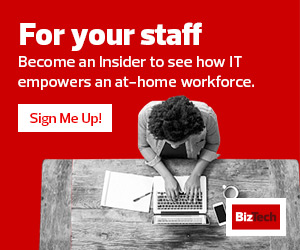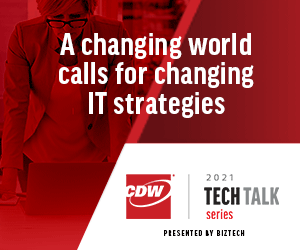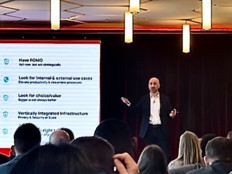The global pandemic has resulted in the creation of new models for what workflows will look like in the coming years. No longer is it a given that people will be primarily working in the office, and it seems likely that things will remain that way for the long term.
At the first weekly session of the 2021 CDW Tech Talk series, host Keara Dowd said businesses have stepped up to continue to serve customers as well as employees.
The challenge now? “Organizations are now tasked with maintaining this level of service long-term,” she said.
That means adapting tools to changing workflows. Tim Ancona, the vice president of CDW ServiceNow solutions, explained during the session that his team had built out a variety of solutions to help companies continue working during the pandemic. One particular success story was the creation of the Safe Workplace suite, which includes an app designed to help businesses come back online safely. The app saw more than 6,000 installations.
“As we started contemplating going back to work, what we knew had to happen is we had to understand where our employees were in terms of their readiness,” he said of the reasoning behind the app. “Were they ready from a wellness standpoint, and did they have the ability to actually go back to work?”
Ancona added that the general approach is design-driven, with a focus on efficiency and maximizing response to create successful outcomes.
How to Manage Complexity Through the Cloud
Of course, it’s not just about simply coming back online anymore. Businesses are trying to thrive in an environment that doesn’t look anything like it did a year ago. Mike Hulme, the senior director for cloud product marketing at VMware, explained that it’s important to manage this complex shift correctly.
“I think that the biggest issue around workforce transformation is its complexity,” he said. “It’s cultural change, it’s infrastructure change, it’s systems access, it’s locations, it's security, it's complex — and it’s also really personal.”
He added that many organizations are moving past the stage of simply reacting to the pandemic and are now considering what the transition will look like long-term within their infrastructure.
“The majority of organizations that we work with are actually in this adapt phase, something that we think is a more proactive stance in redefining what their infrastructure architecture looks like,” Hulme said, adding that these companies are rethinking how they deliver applications and manage remote and hybrid strategies.
MORE FROM BIZTECH: Tips for keeping your data safe with cloud encryption.
Richard Munro, director of global cloud strategy for VMware, added that many organizations have managed to keep the lights on but are now faced with “a number of absolutely pressing challenges that are really demanding us to get more out of our cloud infrastructure services.”
Munro said that one way for technology departments to manage this rapid pace of change is by creating cloud centers of excellence, which help create a broader understanding of what’s happening within the infrastructure of cloud services such as Amazon Web Services and Microsoft Azure, offering visibility into issues and helping to remediate them as they emerge.
“If somebody in a line of business configures an [Amazon] S3 bucket, and they configure it wrong, we can automatically remediate that so that never becomes a risk for an organization,” Munro added.
Strength in Application Support
Hulme and Munro also made the case that a strong but flexible application approach could be a boost to employee morale. Hulme said it could be “a way of really enhancing not just employee experience, but also business performance.”
“It’s really important that we enable a true digital workspace that allows anybody to work in any work style they want,” Munro added. “If we force people to do things in certain narrow ways, we’re not going to see those productivity and morale benefits that we know are the price of getting this right.”
Ancona highlighted the value of strong software with an example of a large school district that needed a way to meet the challenge of supporting remote learning, with thousands of student and parent users to manage.
“The team that we had working with them, right away, recognized that there were some unique solutions … that could really help this particular school district not only get their students back to learning and their teachers back to work but actually enhance the relationships in doing so,” Ancona said.
The approach involved creating a portal, which Ancona said helped bridge gaps between students.
“If they were disadvantaged from a socioeconomic perspective, they were still able to get Chromebooks, they were able to view their homework and able to communicate with their teachers on a regular basis,” he said.
While such approaches are often custom, Ancona noted that ServiceNow aims to build tools that minimize customizations while improving value over time.
“We want to make sure that everything we do is done in a manner that utilizes as much out-of-box technology as possible,” he added.
Follow BizTech’s full coverage of the CDW Tech Talk series here. Insiders can register for the event series here.












